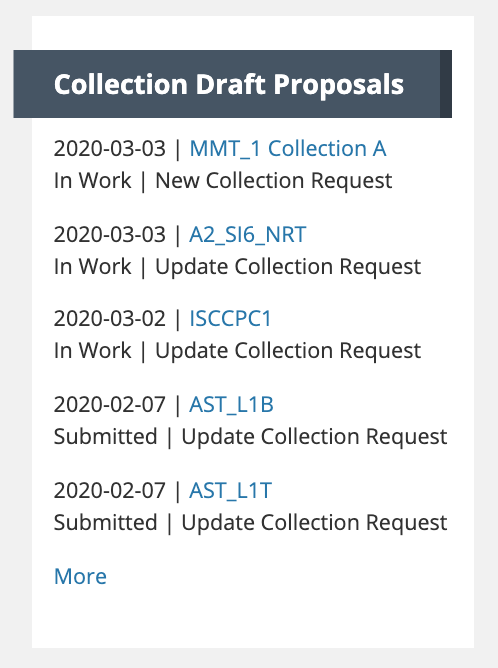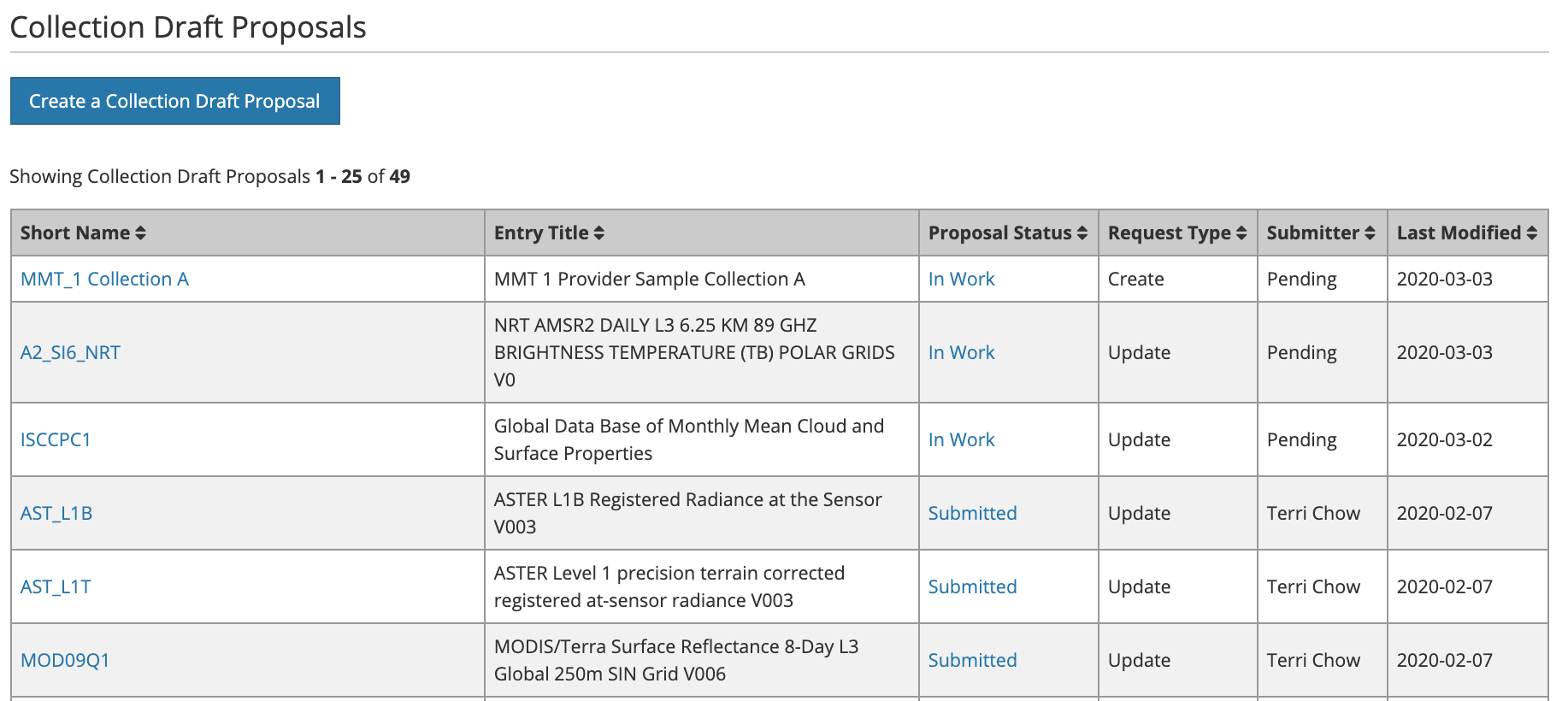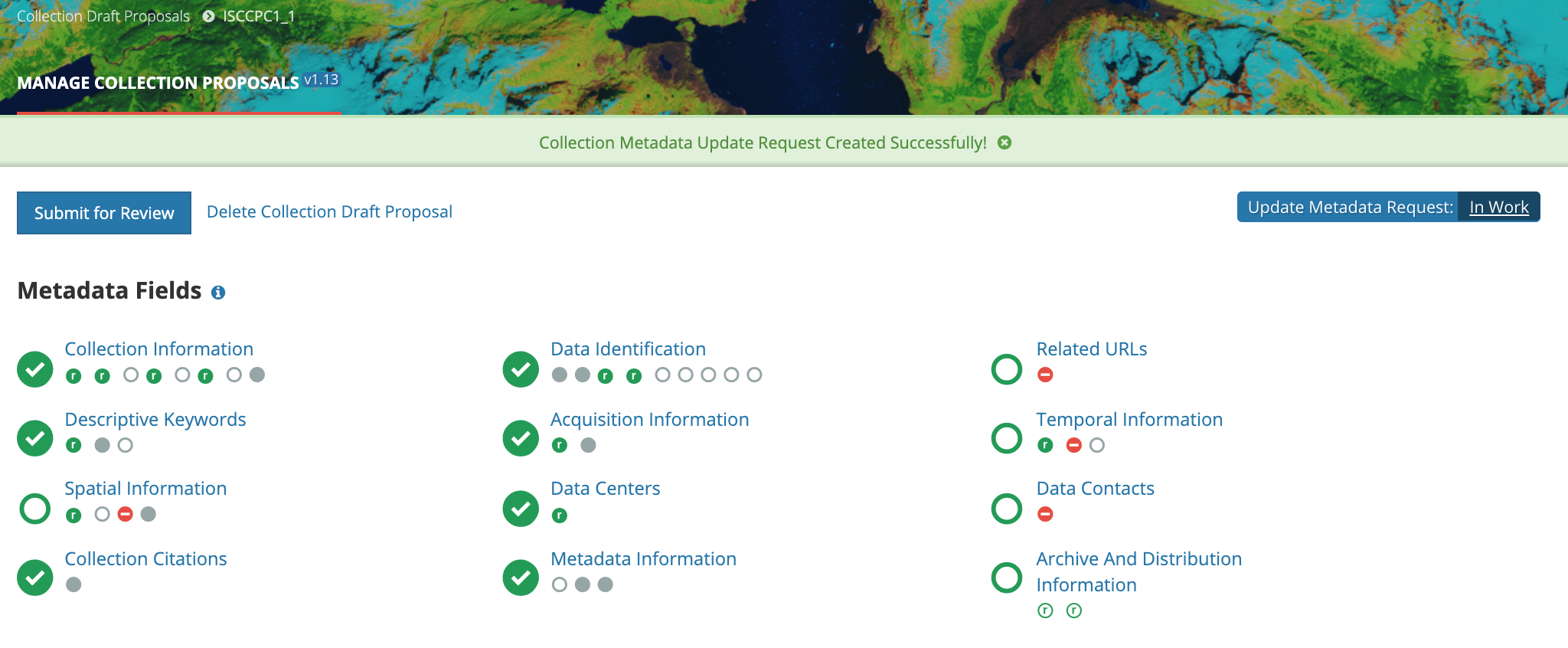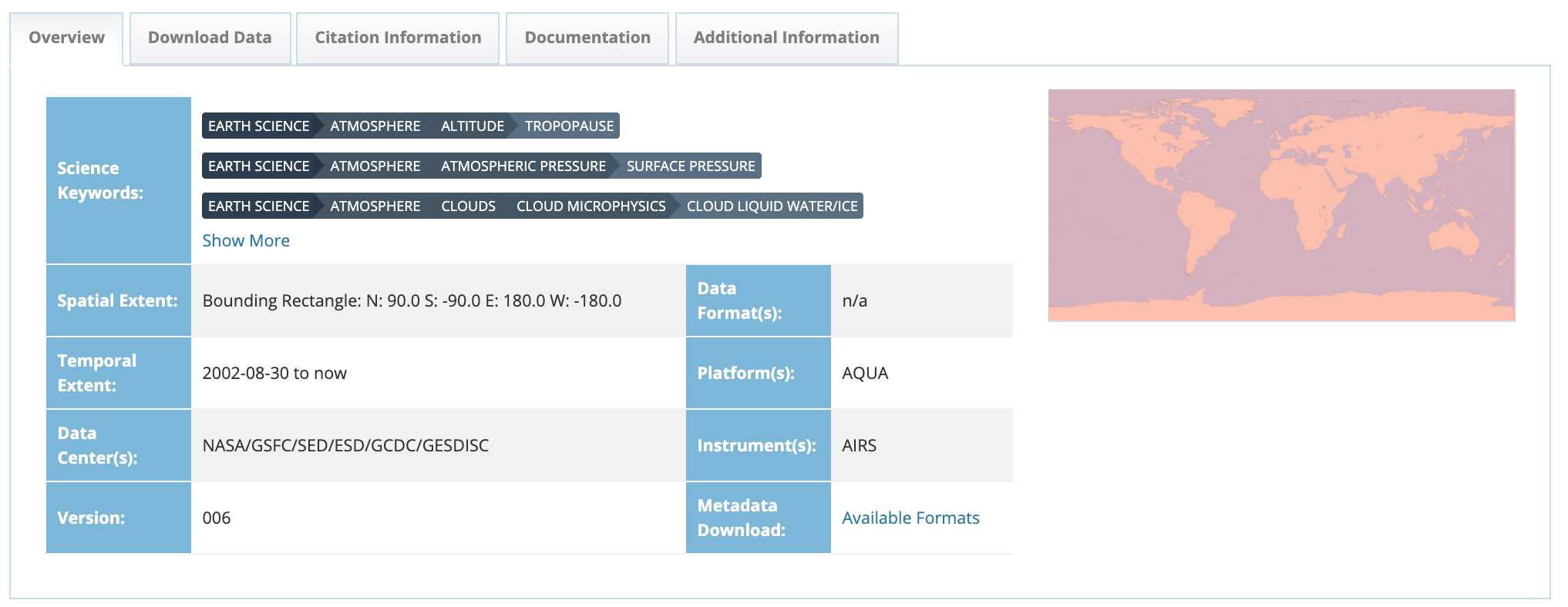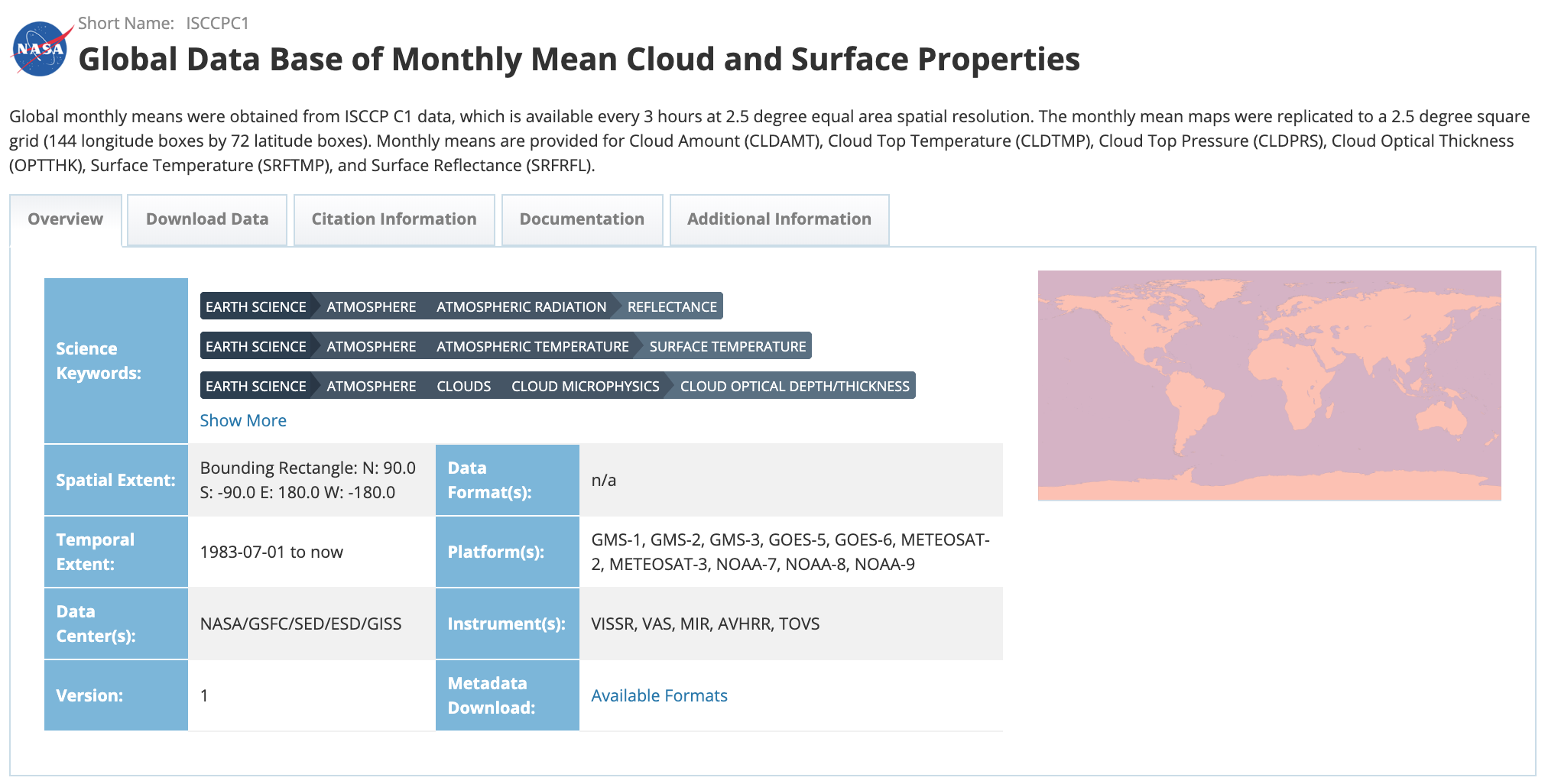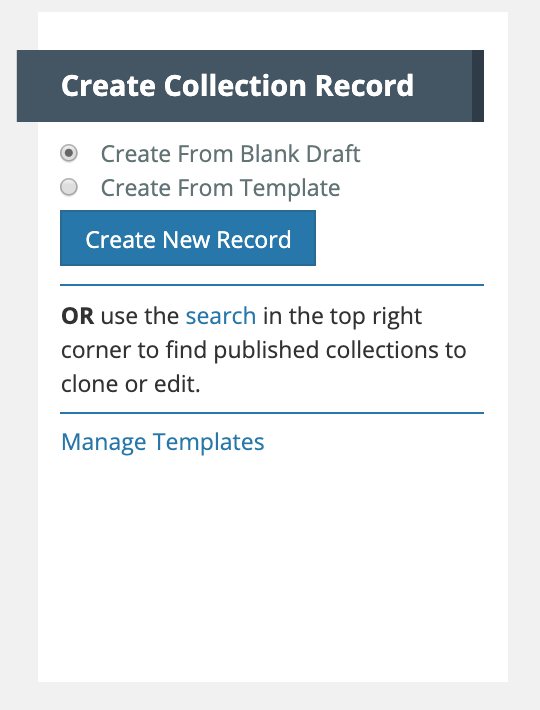Page History
...
This page describes how to use the Draft Metadata Management Tool (dMMT) to perform functions related to Create/Read/Update/Delete/Submit of CMR Collection Metadata Proposals.
The CMR Metadata Best Practices: Landing Page should be referenced for information on the UMM-Collections metadata format.
Accessing the dMMT
...
URL for the Draft Metadata Management Tool
UAT environmentPROD environment: https://draftmmt.uat.earthdata.nasa.gov/
PROD environment: Coming Soon
Provider Context
To use the dMMT, you must have a "non-NASA User" metadata provider context. Ensure that your Earthdata Login username for the appropriate environment (UAT, PROD) has been provisioned with the proper permissions to use the tool.
If you log in to the MMT dMMT but have no provider context set, you will see the following page:
...
Click on either your login name or the arrow to the right of your login name in the upper right corner of the dMMT page, and then click on Logout.
Manage Collection Metadata Records
...
Using the
...
dMMT
Required Permissions
To create, read, update, delete and submit collection metadata proposals, your username must be provisioned with the proper permissions to use the tool.
Contact the CMR OPS team at support@earthdata.nasa.gov if you are not sure whether your username has the correct permissions.
Create
...
and submit a collection metadata proposal
1. On the 'Manage Collection Proposals' dashboard,
...
NOTE: When you are working with a draft collection proposal record, all 'Save' and 'Done' operations update the draft record in the dMMT database, not in the CMR. Your draft collection proposal record will not be published into the CMR until you click on the 'Submit for Review' button, in step 8 below, and it has been approved by NASA-CMR personnel.
5. Follow Follow progress of your draft record on the progress panel:
The icons on the progress panel have the following meanings:
...
8. When all required fields are complete with no validation errors (red icon) showing on the progress panel, you are ready to submit your collection draft proposal record for review. Click on the 'Submit for Review' button above the progress panel on the draft proposal record page:
9. You will see a pop-up window asking you to confirm you want to submit the collection proposal for review.
10. Click on Yes to submit the collection proposal for review. You will then see a green banner indicating that your collection draft proposal record has been successfully submitted for review. , and the status badge will display a 'Draft Proposal Submission: Submitted' status. You will also receive an email stating that your record has been submitted and is under review.
Note: dMMT users will also receive an email when your record has been approved and published to the CMR. If your record is rejected, you will receive an email with a rationale for why it was not acceptable for publishing to the CMRpublished to the CMR.
11. NOTE that you can cancel the proposal submission by clicking on 'Cancel Proposal Submission'. You will see a pop-up message asking you to confirm you want to cancel the proposal submission.
12. Click on Yes to cancel the proposal submission. The dMMT will then display a 'Collection Draft Proposal Canceled Successfully.' message, and the status badge will display a 'Update Metadata Request: In Work' status.
Check the status of your collection proposal submission in the dMMT
1. On the 'Manage Collection Proposals' dashboard, click on 'More' at the bottom of the 'Collection Draft Proposals' call-out box.
2. A table of collection proposals will be displayed. You may view the status of a proposal by clicking on the status link in the 'Proposal Status' column.
3. The dMMT will display a detailed page showing the draft proposal's review status. Submission can also be canceled from this page.
Note: If your record is rejected, the rationale for why it was not published to the CMR will be displayed in the 'Progress' box.
Find and view published collection records in the CMR
...
To view an html representation of the metadata for any collection record in the search results table, click on the Short Name of the collection.
...
Submit a request to update a published collection record in the
...
CMR using the dMMT
1. Find the collection record using the instructions above ('Find and View Published Collections in the CMR)', and click on the Short Name of the collection to view the collection information page.
2. At the top of the collection information page, click on 'Edit Collection RecordCreate Update Request'.
3. A new draft of this record will be created in the MMT dMMT database. The MMT dMMT will display the progress panel (and html representation) for the draft record.
4. On the progress panel, click on any section to begin editing the draft record. Use the progress panel and navigation buttons described in in 'Create a collection record in the CMR for my provider to update and Submit a Collection Metadata Proposal' to update the metadata in the draft record.
5. When you have finished editing the draft record, publish it to the CMR submit it for review by clicking on the Publish Draft 'Submit for Review' button above the progress panel on the draft proposal record page:
6. You will see a pop-up window asking you to confirm you want to submit the collection proposal for review.
7. Click on Yes to submit the collection proposal for review. The dMMT will then display a green banner with a 'Collection Draft Proposal Submitted for Review Successfully!' message, and the status badge will display a 'Update Metadata Request: Submitted' status.
You will also receive an email stating that your record has been submitted and is under review.
Note: dMMT users will also receive an email when your record has been approved and published to the CMR. If your record is rejected, you will receive an email with a rationale for why it was not acceptable for publishing to the CMR.
After the collection proposal is approved and published, . This will create a new revision of the collection record is created in the CMR. The CMR stores up to 10 revisions of each collection record. When an 11th revision is created, the first revision is deleted, and so on. Each revision of a collection record has the same concept id as the original collection record.
Clone and edit a collection record in the CMR for my provider
1. Find the collection record using the instructions above (Find and View Collections in the CMR), and click on the Short Name of the collection to view the collection information page.
2. At the top of the collection information page, click on 'Clone Collection Record'
3. A draft of a clone of this record will be created in the MMT database. The MMT will display the progress panel (and html representation) for the draft record (the clone).
Since collection Short Names must be unique, the clone is initiated with a blank short name. The Entry Title of the clone will be initialized to '<entry title of the original record' - Cloned'. You may edit the record to change the default entry title of the clone.
NOTE: A prompt to enter a new short name for the clone appears in the blue bar, and the progress panel indicates that the Short Name has not yet been filled in.
4. On the progress panel, click on any section to begin editing the draft record (the clone). You must enter a new Short Name for the clone. Use the progress panel and navigation buttons described above (Create a collection record in the CMR for my provider) to update the metadata in the draft record.
5. When you have finished editing the draft record (the clone), publish it to the CMR by clicking on the Publish Draft button above the progress panel. The clone will be stored as a new collection record in the CMR, with a different concept id from the original record.
8. NOTE that you can cancel the update record request by clicking on 'Cancel Update Request'. You will see a pop-up message asking you to confirm you want to cancel the proposal submission.
6. Click on Yes to cancel the update request. The dMMT will then display a 'Collection Draft Proposal Canceled Successfully.' message, and the status badge will display a 'Update Metadata Request: In Work' status.
Download XML for a collection record in the CMR using the dMMT
1. Find the collection record using the instructions above ('Find and View Published Collections in the CMR)', and click on the Short Name of the collection to view the collection information page.
2. On the Overview tab of the collection information page, click on Metadata Download: 'Available Formats'.
3. You will see a pop-up window asking you to choose the format in which you would like to download the collection metadata.
4. Click on the format that you would like. Your browser and local machine will now prompt you through the download process.
...
Submit a request to delete a published collection record in the CMR
...
using the dMMT
1. Find the collection record using the instructions above ('Find and View Published Collections in the CMR)', and click on the Short Name of the collection to view the collection information page.
2. At the top of the collection information page, click on 'Submit Delete Collection RecordRequest'.
3. You will see a pop-up message asking you to confirm the record deletion request.
4. Click on Yes to submit the delete the recordrequest. The MMT dMMT will then display a green banner with a 'Collection Deleted Metadata Delete Request Created Successfully!' message, and the status badge will display a 'Delete Metadata Request: Submitted' status.
After the delete request is approved and processed, the as well as the revision history for the deleted record. The CMR will create a final revision for the deleted record, which is called a tombstone.
5. NOTE that you can immediately restore cancel the deleted record from one of the revisions on this Revision History table delete record request by clicking on 'Reinstate', but once you have moved to a new page on the MMT, you will no longer be able to find the deleted record to restore it. If you restore the record from this table, you will see a new revision history, showing the deletion as one of the revisions:
Revert to a previous revision of a collection record in the CMR for my provider
1. Find the collection record using the instructions above (Find and View Collections in the CMR), and click on the Short Name of the collection to view the collection information page.
2. At the top of the collection information page, click on 'Revisions (<number of revisions>)'
3. A table of the (up to) 10 most recent revisions of the collection record will be displayed.
4. You may View previous revisions of the record by clicking on the 'View' link next to the Revision Description. After you determine which revision you want to revert to, click on 'Revert to this Revision' in the Actions column for that revision. You will see a pop-up message asking you to confirm the action:
5. Click on Yes to revert to the selected previous revision of the record. The MMT will then display a 'Revision Created Successfully!' message, as well as the new revision history for the record. If there were n revisions before you reverted to a previous revision, there will now be n+1 revisions, and the n+1st revision will be identical to the previous revision to which you reverted.
Create and Manage Collection Record Templates
Create a collection record template for my provider
On the 'Manage Collections' dashboard, in the Create Collection Record panel, click on ‘Manage Templates’.
2. On the provider templates page, click on ‘Create a Collection Template’. A draft collection record template will be created.
3. Begin filling in metadata fields for your draft collection record. Use the information icons (blue 'i') to get information about what fields mean and how to format their values.
4. Navigate from form to form using the Previous or Next buttons, or by choosing the next form to edit from the pull-down list at 'Save & Jump To:'. You may work on forms in any order. When you move from one form to another, your input from the previous form will be saved in your draft record template. Explicitly Save form input (within a session or at the end of a session) with the 'Save' button. To save your draft record template, select the 'Done' button.
You will see a green banner indicating that your collection record template has been successfully created. NOTE: When you are working with a draft collection record template, all 'Save' and 'Done' operations update the draft record template in the MMT database, not in the CMR. Draft collection record templates can be used to create draft collection records that can then be ingested into the CMR.
5. Follow progress of your draft record template on the progress panel:
The icons on the progress panel have the following meanings:
6. View an HTML rendering of your collection record template on the 'preview panel':
7. Special NOTES when creating or editing a collection level record template:
a. To have the NRT (Near Real Time) badge appear for the collection on the Earthdata Search Client, set Collection Type to 'Near Real Time' on the 'Data Information' form.
b. On the 'Temporal Extent' form, Ends at Present should be set to False if there is an end date for the collection.
c. NASA data centers are strongly encouraged to provide DOI information for the Collection on the 'Collection Information' form.
Cancel Delete Request'. You will see a pop-up message asking you to confirm you want to cancel the record deletion request.
6. Click on Yes to cancel the delete request. The dMMT will then display a 'The request to delete the collection Short Name: xxx has been successfully canceled.' message.
Report problems or get help with dMMT
- Use the Feedback link at the right of the black 'Tophat' dMMT page header to report problems or get help with the MMTdMMT.
- Send email to support@earthdata.nasa.gov
...







